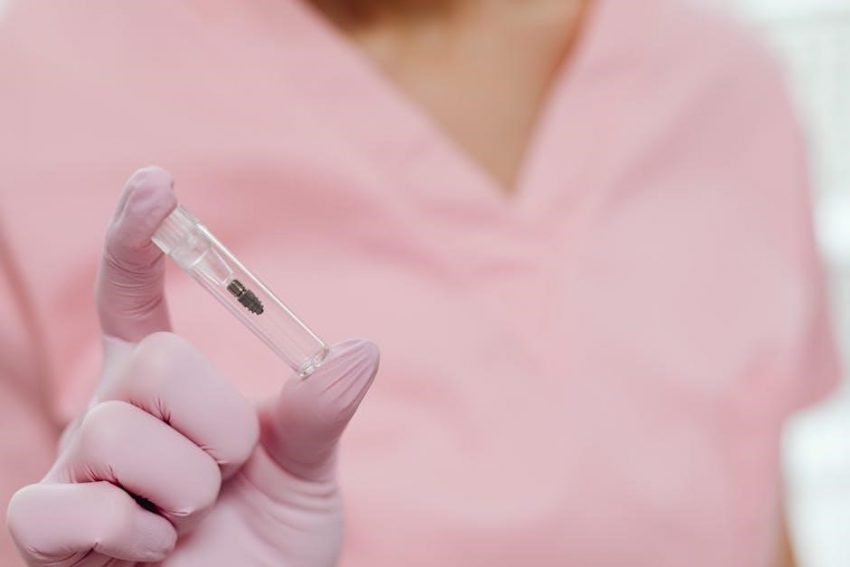This guide provides essential steps for caring after dental implant surgery, ensuring proper healing, minimizing complications, and promoting a smooth recovery. Follow these instructions carefully for optimal results.
Overview of Dental Implant Surgery and Recovery
Dental implant surgery involves placing a titanium post into the jawbone to support a prosthetic tooth. The procedure is typically straightforward, with minimal bleeding and discomfort. Immediate recovery begins with managing swelling and pain, often using ice packs and prescribed medications. The initial healing phase lasts 1-2 weeks, during which swelling subsides and the implant integrates with the bone. Full recovery and osseointegration take 3-6 months, after which the final crown is placed. Proper post-operative care is crucial to prevent complications and ensure the implant’s long-term success. Following the provided instructions helps promote healing, minimize discomfort, and achieve optimal results.

Immediate Post-Surgery Care
Rest is crucial after implant surgery. Limit activity, avoid strenuous tasks, and keep the surgical site clean. Follow specific guidelines to promote healing and minimize discomfort.
Bleeding Management After Dental Implant Surgery
Minor bleeding or oozing is normal after dental implant surgery. To manage it, bite firmly on the provided gauze for 30-60 minutes. If bleeding persists, replace the gauze with a clean one and continue applying pressure. Avoid spitting, rinsing, or drinking through a straw, as this can dislodge the blood clot. If bleeding increases or doesn’t stop after 24 hours, contact your dentist immediately. Elevating your head while resting may also help reduce bleeding. Follow these steps carefully to ensure proper clotting and promote healing. Remember, slight bleeding is a common part of the recovery process, but excessive bleeding requires attention.
Swelling and Ice Application Guidelines
Swelling is a common and expected part of the healing process after dental implant surgery. To minimize swelling, apply an ice pack or a plastic bag filled with ice to the affected area. This should be done continuously for the first 24 to 36 hours. Ensure the ice is wrapped in a cloth to avoid direct contact with the skin. Applying ice will help reduce both swelling and discomfort. Additionally, keeping your head elevated while resting can further minimize swelling. Follow these guidelines carefully to promote a smooth recovery and reduce post-operative discomfort;
Activity Restrictions for the First 24 Hours
Rest and relaxation are crucial during the first 24 hours after dental implant surgery. Avoid strenuous activities, bending, heavy lifting, or any actions that may increase heart rate or blood pressure. Refrain from exercising or engaging in physical labor, as this can dislodge the blood clot and delay healing. Light activities can typically resume the following day if you feel well enough. However, avoid extreme exertion for the first 48-72 hours. By adhering to these restrictions, you can protect the surgical site and ensure proper healing. This period is essential for allowing your body to recover and integrate the implant successfully.
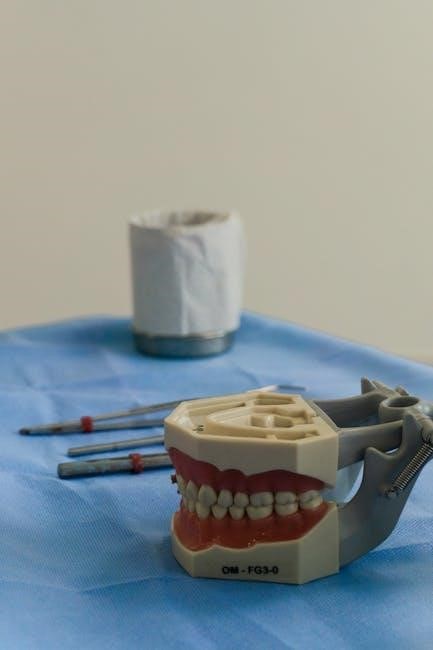
Managing Swelling and Pain
Swelling and pain are common after dental implant surgery. Apply ice packs to reduce swelling, and take prescribed pain medications as directed. Rest and avoid strenuous activities to aid recovery.
Using Ice Packs to Reduce Swelling
Apply an ice pack to the swollen area to minimize swelling after dental implant surgery. Wrap the ice in a cloth to avoid direct skin contact. Use the ice pack continuously for the first 36 hours, taking breaks every 15-20 minutes. This helps reduce inflammation and eases discomfort. Ice therapy is most effective when started immediately after surgery. Avoid placing ice directly on the skin to prevent irritation. If swelling persists or worsens, consult your dentist for further guidance. Ice packs are a simple yet effective way to manage post-operative swelling and promote a smoother recovery process.
Pain Management Techniques and Medications
Managing pain after dental implant surgery is crucial for a comfortable recovery. Take prescribed pain medications as directed by your dentist, starting with over-the-counter options like ibuprofen or acetaminophen. These can be taken as soon as the local anesthetic wears off. Avoid strenuous activities that may exacerbate discomfort. Gently rinse your mouth with warm salt water to soothe sore areas. If pain persists or worsens, contact your dentist for further evaluation. Proper pain management ensures a smoother healing process and reduces the risk of complications. Always follow the medication schedule provided and avoid exceeding recommended dosages. Monitor your pain levels and adjust your medication intake accordingly to stay comfortable during recovery.

Post-Operative Dietary Recommendations
Stick to a soft food diet for the first few days, such as yogurt, smoothies, and pureed foods. Avoid hot, hard, or crunchy foods to prevent discomfort or complications.
Soft Food Diet for the First Few Days
A soft food diet is crucial during the initial healing phase after dental implant surgery. Opt for foods like yogurt, scrambled eggs, mashed potatoes, and smoothies. Avoid hot, hard, or crunchy foods that could irritate the surgical site. Soups and pureed meals are also excellent choices. Ensure to drink plenty of fluids to stay hydrated. Avoid using straws, as the suction can dislodge the blood clot. Stick to cold or room-temperature foods for the first 24 hours to reduce swelling. Gradually introduce softer solids as comfort allows, but avoid chewing directly over the implant site. This dietary approach helps minimize discomfort and supports proper healing during the recovery process.
Liquid and Pureed Food Options
Liquid and pureed foods are ideal immediately following dental implant surgery, as they require minimal chewing and are gentle on the surgical site. Clear broths, fruit juices, and smoothies are excellent choices. Pureed foods like applesauce, mashed bananas, and blended soups are also recommended. These options provide essential nutrients without irritating the implant area. Avoid hot liquids for the first 24 hours to prevent discomfort. Ensure to maintain a balanced diet to support healing. Gradually introduce softer foods as comfort allows, but continue to avoid anything that requires heavy chewing. This approach minimizes irritation and promotes a smooth recovery during the initial healing phase.
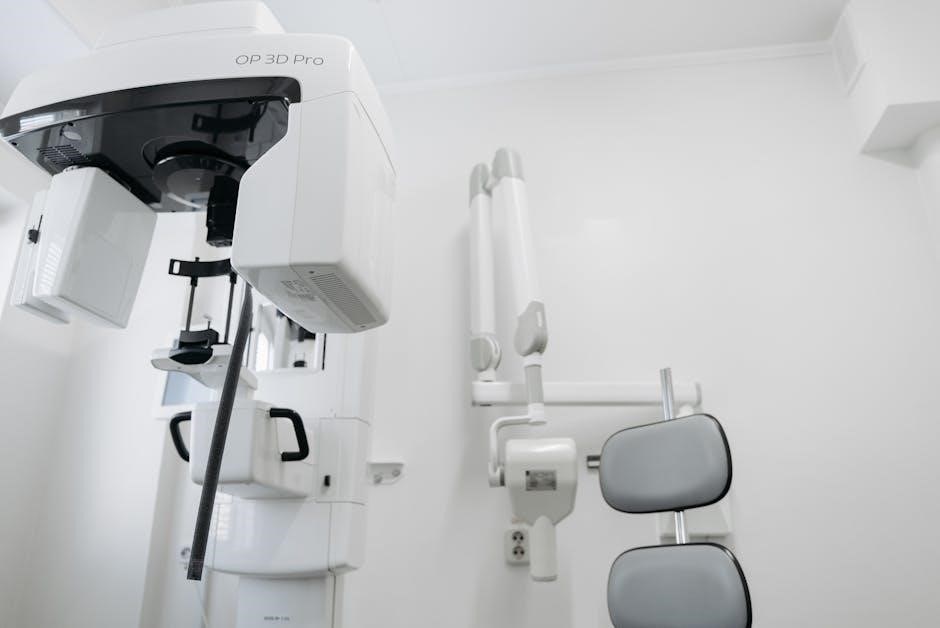
Oral Hygiene During Recovery
Practicing good oral hygiene is crucial after dental implant surgery. Avoid rinsing or spitting forcefully, and use a prescribed mouthwash to keep the area clean. Gentle brushing around the implant site is recommended, but avoid disturbing the surgical area. Your dentist may provide specific instructions for cleaning to ensure proper healing and prevent complications. Maintaining a clean environment promotes recovery and implant success.
Rinsing and Cleaning the Mouth
Gentle oral hygiene practices are vital during the recovery period. Avoid rinsing or spitting forcefully for 24 hours after surgery. On the first day, refrain from using mouthwash. Starting the next day, rinse with a saline solution (1/2 teaspoon of salt in 8 ounces of warm water) or a prescribed mouthwash, gently swishing around the mouth, especially near the implant site. Repeat this 2-3 times daily to keep the area clean. Avoid using harsh mouthwashes or abrasive products that could irritate the healing tissue; Continue this routine for 1-2 weeks or as directed by your dentist. Proper cleaning helps prevent infection and supports healing.
Gentle Brushing Techniques
Resume gentle brushing 24 hours after surgery, using a soft-bristled toothbrush. Avoid the surgical site but clean surrounding teeth and gums normally. For the implant area, lightly brush with a soft toothbrush, focusing on plaque removal without applying pressure. Do not use electric toothbrushes or abrasive toothpaste during the initial healing phase. Gentle brushing helps maintain oral hygiene without disrupting the healing process. Avoid disturbing the implant site, as this could interfere with osseointegration. Continue this gentle approach for 2-4 weeks or as advised by your dentist. Proper brushing supports healing and prevents complications, ensuring the implant integrates successfully with the surrounding bone and tissue.
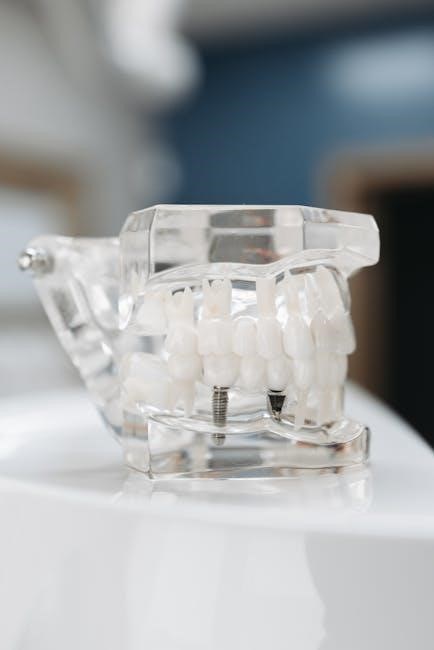
Monitoring for Complications
Monitor for signs of infection, such as fever, swelling, or pus, and watch for implant mobility. Contact your dentist immediately if unusual symptoms arise to prevent failure.
Signs of Infection to Watch For
Monitor for signs of infection, such as increased redness, swelling, or pus around the implant site. Fever, persistent pain, or a bad taste in the mouth may also indicate infection. If you notice unusual bleeding, implant mobility, or swelling that worsens after 3-4 days, contact your dentist immediately. Avoid ignoring these symptoms, as untreated infections can lead to implant failure. Early detection and treatment are crucial to ensure proper healing and long-term success of the implant. Keep track of your recovery progress and seek professional advice if any unusual symptoms arise.
Preventing Implant Failure
To ensure the success of your dental implant, adhere to post-operative instructions carefully. Avoid disturbing the implant site, as this can disrupt the healing process. Refrain from smoking, as it significantly increases the risk of implant failure. Stick to a soft food diet during the initial healing phase to prevent mechanical stress on the implant. Maintain good oral hygiene by gently rinsing with saline solution and avoiding harsh brushing near the implant site. Attend all follow-up appointments to monitor healing progress. Proper care and adherence to these guidelines will minimize the risk of complications and ensure the long-term success of your dental implant.
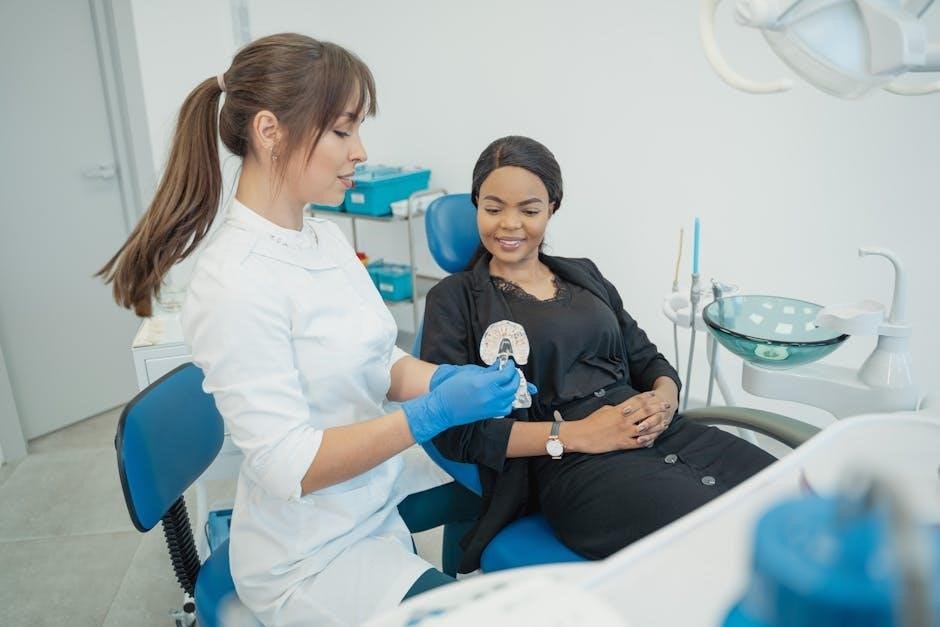
Pain and Discomfort Solutions
Manage pain with prescribed medications or over-the-counter pain relievers as directed. Apply ice packs to reduce swelling, and avoid strenuous activities to minimize discomfort during recovery.
Recommended Pain Relief Medications
For managing pain after dental implant surgery, over-the-counter medications such as ibuprofen (e.g., Advil) or naproxen (e.g., Aleve) are often recommended due to their anti-inflammatory properties. Acetaminophen (e.g., Tylenol) is also effective for pain relief without inflammation reduction. Always follow the dosage instructions provided by your dentist or on the medication label. If pain is severe, your dentist may prescribe stronger pain relievers. It’s important to start taking pain medication before the numbness wears off to ensure effectiveness. Additionally, antibiotics may be prescribed to prevent infection, so take them as directed. If pain persists or worsens despite medication, contact your dentist immediately for further evaluation.
Alternative Methods for Pain Relief
Beyond medication, several alternative methods can help manage discomfort after dental implant surgery. Applying an ice pack to the affected area can reduce swelling and numbness, providing temporary pain relief. Resting and avoiding strenuous activities allows your body to heal faster. A soft-food diet minimizes chewing strain on the implant site. Gentle rinsing with warm saltwater can also soothe the area. Additionally, relaxation techniques like deep breathing or meditation may help reduce discomfort. Avoiding smoking and alcohol is crucial, as they can delay healing and increase pain. These methods, combined with prescribed medications, can enhance your recovery experience and reduce post-surgical pain effectively.

Long-Term Care and Follow-Up
Regular check-ups with your dentist are crucial for monitoring the implant’s healing progress and ensuring long-term success. Proper care ensures durability and functionality of the implant.
Healing Timeline and Stages
The healing process after dental implant surgery typically spans several months, with distinct stages ensuring proper osseointegration and tissue recovery. Immediately after surgery, the body begins to form a blood clot around the implant, which is crucial for initial healing. Over the next few weeks, the jawbone starts to integrate with the implant surface, a process known as osseointegration. This stage is vital for the implant’s stability and longevity. After 3-6 months, depending on the implant type and location, the implant is ready for the final restoration. Regular follow-ups with your dentist ensure the healing progresses smoothly, and any adjustments can be made to achieve optimal results.
Importance of Follow-Up Appointments
Follow-up appointments are crucial for monitoring the healing progress of your dental implant and ensuring long-term success. These visits allow your dentist to assess the implant’s integration with the jawbone, check for any signs of complications, and confirm proper healing. Regular check-ups also provide an opportunity to address any concerns or discomfort you may have. Additionally, follow-ups are necessary for scheduling the next stages of treatment, such as placing the abutment or final crown. By attending all recommended appointments, you can ensure your implant functions optimally and lasts for many years. Consistent communication with your dental team is key to achieving a successful and durable outcome.
By adhering to post-operative instructions, patients can ensure a smooth recovery, minimize complications, and achieve optimal results from their dental implant procedure. Proper care leads to long-term success.
Final Tips for a Smooth Recovery
For a seamless recovery, prioritize rest, adhere to your prescribed diet, and maintain meticulous oral hygiene. Avoid smoking or consuming alcohol, as these can hinder healing. Keep the surgical site clean by gently rinsing with saline water and using prescribed mouthwash. Attend all follow-up appointments to monitor progress and address concerns. Mild exercise can resume after 24 hours, but avoid strenuous activities for at least a week. Stay hydrated and eat nutrient-rich foods to support healing. If pain or swelling persists, contact your dentist promptly. By following these guidelines, you can ensure a successful recovery and enjoy the long-term benefits of your dental implants.
